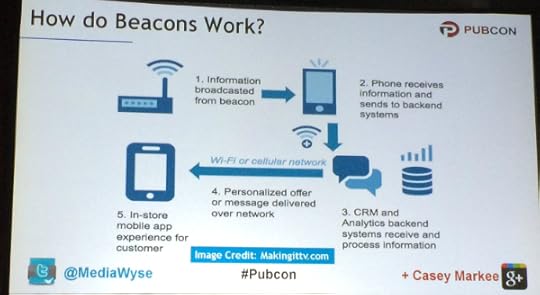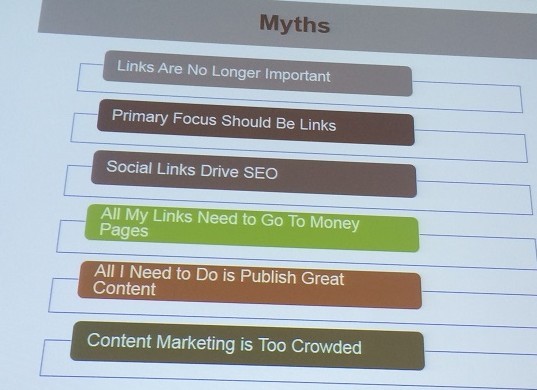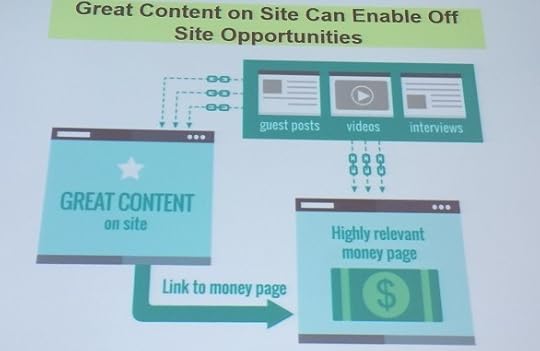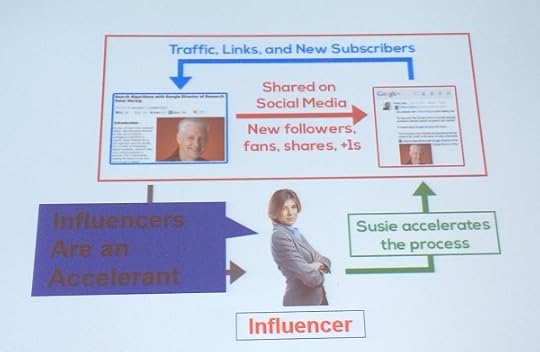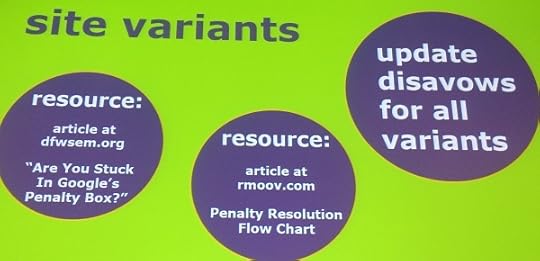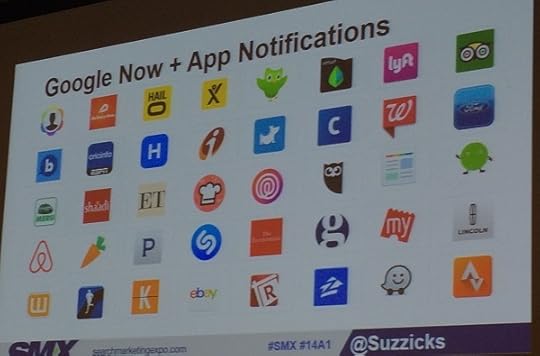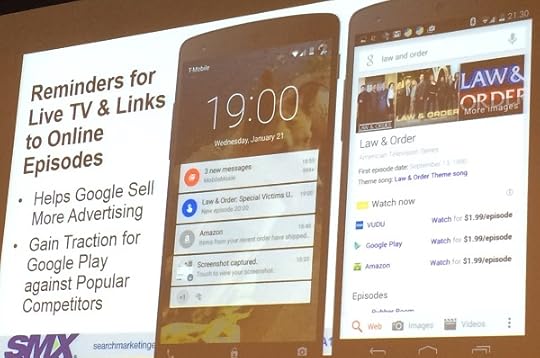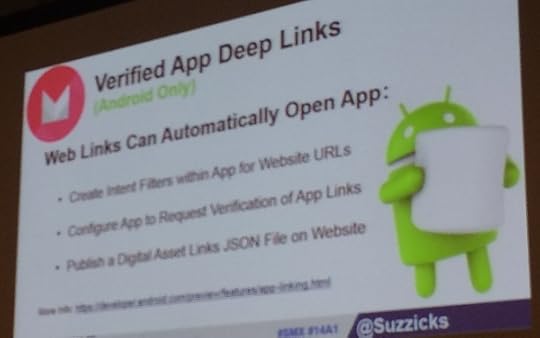Bruce Clay's Blog, page 23
October 6, 2015
Beyond SEO: Marketing for Wearable Technology & Beacons – #Pubcon Liveblog
Beyond SEO: Marketing for Wearable Technology & Beacons – #Pubcon Liveblog was originally published on BruceClay.com, home of expert search engine optimization tips.
The Pubcon session called “Beyond SEO: Market Intersection Optimization” is really about marketing to users with wearable technology — including using beacons for hyperlocal marketing, and tips for creating social media and content for wearable devices such as Apple Watches.
Moderator Peter Leshaw (@peterleshaw) is a few thousand miles away from where he lives, yet he can tell us that right now he has five eggs in his refrigerator, and the one farthest to the right is the oldest. He has an app for his Moto360 wearable called Egg Minder. Casey Markee (@mediawyse) and Caitlin Jeansonne (@qcait) will tell us about how wearable devices are affecting social media and everyday life, and how to adopt marketing strategies for wearable tech.
Casey Markee: Wearables Hyperlocal Marketing with Beacons
Beacons are bringing personalized marketing to a whole new realm. Here’s his agenda for this presentation:
“In order to be successful, any given piece of wearable technology has to be useful the entire time it’s on your body.” –Nilay Patel, The Verge
Wearables Market Overview
In 2014, 89 different companies sold smartwatches, mostly Android. The average cost was $189.
Smartwatches are defined as providing time and having a wireless connection.
Compare 2014 to the market in 2015. Apple is the new king of the wearables market.
The only close competitor is Fitbit.
There have been four million Apple Watches sold for $3+ billion in revenue, and it’s the most successful product to date. It only took one day for Apple to sell a million Apple Watches. There’s projection that the Apple Watch will be the most in-demand product of the 2015 holiday season.
Rolex was previously the largest luxury brand revenue generator. Apple is expected to triple their records, making them the new luxury watch king.
Forecast: By 2018, smartwatches alone will move 91.6 million units. A lot of people will have a smartwatch, most likely an Apple Watch, by the end of the year. As SEOs, we must target our clients’ audiences on these platforms. That’s what we’re talking about when we’re talking about wearables SEO.
Beacons: Hyperlocal Targeting
Hyperlocal marketing is delivering a personalized marketing message for a product or service in real-time to target consumers exactly when they need it.
How do you do this? With beacons! The beacon options are:
Apple’s iBeacon
Google Eddystone
Facebook Beacons
Beacon Stack is an industry review site that compares various beacon technology.
How do beacons work?
What can a consumer do with the help of beacons?
Get product coupons
Ask for assistance
Get a welcome and specific offers
Follow an indoor store map
Facebook Beacons: Cool but limited
Facts for marketers:
Available for any retail or local business with a verified Facebook account.
Facebook “Places Tips” trigger when within 100 feet of a beacon.
Serve a “Welcome Note” to visitors.
Serve prompts to Like the page or check in.
Feature posts from your page or those of your fans.
Apple iBeacons: App-focused and hot
App-based – mandatory for messages
Proprietary – does work on Android with a lot of requests
Can send messages only through UUID (Universal Unique Identifier)
No use of EIDs – This is their biggest drawback; you can’t track lost luggage, asset tracking across a fleet of trucks.
Google Eddystone: New Kid on the Block
This beacon supports URL and app for messaging.
Anyone can use Eddystone beacons to submit alerts through a URL, UUID, EID.
Contextual ability is great and more than with other options.
Restaurants can push happy hour specials. He compares it to the most like Tom Cruise walking through the mall.
Why use beacons? It makes visitors/customers more likely to buy and spend more money!
iBeacon Case Study: Marsh Supermarkets in Indiana
This is the most famous beacon case study (http://bit.ly/ibeacons-101). He expects more retailers will make capabilities like this cross-platform with Eddystone next.
Eddystone Case Study: TriMet PTA in Oregon
Arrival and departure date of trains closest to them. It’s like an expanded version of Google Now cards.
If this is new to you, talk to clients and ask if there’s a way for you to provide a personalized option that uses bluetooth beacons.
Caitlin Jeansonne: Apple Watch and Wearables Affecting Social Media Marketing
What are people talking about related to wearables? Here are the trending keywords:
Health
Apple Watches
Holiday gifts
Target (will be selling the Apple Watch soon)
1. Wearables have the potential to cut through consumers’ natural ad block.
We see over 5,000 branded messages in a day, and we’re pretty good at filtering them out. Because wearable technology is attached to us and tied into our lives, marketers who can tap into that will cut through the noise.
2. The rise of new social communities around connected objects.
There are growing and engaged communities using lots of hashtags and sharing across platforms (Instagram + Fitbit community, for example). Opportunities include finding a way your brand can participate in a community in a meaningful way. Look for micro-influencers.
3. Increased speed of engagement.
When someone posts about a brand, there’s an expectation of a faster response. 42% of people who reach out to a brand expect a response in an hour. Another 25% expect a response in a day. 65% of brands respond within a day – that’s basically the minimum today. As wearables adoption increases, that timeline will likely shorten.
4. More data means more targeting options, but screen size is limited.
5. Content becomes even more concise.
Tell Domino’s your default setting (where you live and your food order), and then you can send a single character — the pizza emoji — to place your order.
Emojis and emoticons are additional things in our toolkit that can shorten the message and the meaning. Think about that in terms of your logo and other imagery. What short snippets of content are you using that your customers see and immediately think of you?
6. Storytelling remains key.
This is the heart of all social media platforms. Telling the brand story to connect in a meaningful way is our goal.
Instagram on an Apple Watch is just the image and then you can scroll down to see the caption. Let that image tell the story.
7. Call to action changes.
On the Apple Watch, Twitter app users can’t click a link. Users can retweet, reply, favorite and follow. Think of which of those CTAs make the most sense.
8. Privacy becomes more nuanced.
People will become more aware of the data they are sharing, as well as when and how. When they start to see ads related to a wearable they’re using, they’ll connect that to their device and privacy settings.
Humana, the health insurance agency, lets you tie in all your fitness wearables and gives you points for doing things like exercising, points which you can redeem for Amazon gift cards and the like.
9. Useful content wins.
This is always true. As brands, think of how to provide the most value to customers.
Takeaways
Know your audience.
Tell your brand story in a meaningful and concise way.
Look for opportunities for micro-content.
Beyond your logo, define brand assets including commonly used images and taglines.
Seek to provide value.
Monitor social conversations about your brand/industry.
Stay on top of wearable technology developments.
Guy Kawasaki’s 10 Tips: How to Perfect Your Marketing
Guy Kawasaki’s 10 Tips: How to Perfect Your Marketing was originally published on BruceClay.com, home of expert search engine optimization tips.
Guy Kawasaki is a name-brand marketing pro and an evangelist. He’s the author of The Art of Social Media, The Art of the Start, APE: Author, Publisher, Entrepreneur, Enchantment, and has a million and a half Twitter followers who follow him for his marketing insights. The topic he’s sharing with this crowd of marketers is how to improve your marketing in the age of social media, the democratization of platforms.
There are two salient points he’s observed about high tech speakers. Almost all of them suck and almost all of them go long. That’s a bad combination. If you suck and you’re short, it’s okay, and if you’re great and you’re long, you’re okay. So he’ll be focusing on 10 points so if you think it sucks then you know how much longer it will go. 
October 2, 2015
Link Auditing and Best Practices for Acquiring Authoritative Links – SMX Liveblog
Link Auditing and Best Practices for Acquiring Authoritative Links – SMX Liveblog was originally published on BruceClay.com, home of expert search engine optimization tips.
In April 2012, Penguin made its first flaps in the Google algorithm. Since that time, the SEO industry has developed stringent best practices around link building, also called link acquisition or link earning, and backlink auditing and SEO penalty removal. This SMX East session starts with timeless methods to attract quality relevant links through content marketing. Then speakers lay out the backlink auditing process and critical tools for link research and removal.
Moderator: Alex Bennert, SEO Consultant, Independent (@alexbennert)
Spotlight sponsor: Bruce Clay, Founder and President, Bruce Clay, Inc. (@bruceclayinc)
Speakers:
Eric Enge, CEO, Stone Temple Consulting (@stonetemple)
Megan Geiss, Director, Marketing Strategy, Merkle | RKG (@MeganGeiss)
Sha Menz, Penalty Recovery Specialist, rmoov.com (@ShahMenz)
Bruce Clay kicks off the session on link building and auditing by explaining how we can crowdsource disavow files. We give Google our disavow files and have no idea if our links have been disavowed, or if we our own site and links have been disavowed. As individuals and as an industry, we can collectively empower ourselves to get all that info we give Google. Users of DisavowFiles can tell if someone is linking to you with a link that’s been disavowed. It’s a tool designed for the Bruce Clay, Inc. SEO analysts and it’s free for all to use.
Since launching the tool at SMX Advanced this past June, here are stats of DisavowFiles users and how many disavowed links are included in the DisavowFiles database. Enter your site into the external lookup tool at DisavowFiles.com to see if your pages have been disavowed now!
Eric Enge: How to Excel at Content Marketing Or, How Can I Get Me Some?
Content marketing is a way to build SEO value, and overall reputation and visibility online.
Little known fact: He had brain surgery in 2003. It’s a long story, it’s all fine, and 100% fixed.
So, how does content marketing drive SEO? There are a number of myths:
Content marketing goals:
Build your reputation
Grow your visibility
Grow your audience
Yes, get some links too
Why links are secondary:
Google risk reduction
It’s about the ecosystem
The ecosystem is about relationships
Focusing on links strains relationships
The content marketing approach gets the best links anyway
Today’s environment online is an ecosystem.
You should be reaching out to media, influencers, bloggers, and your audience.
The basic mechanics of content marketing:
1. Publish great content on your site.
Great content… it’s important to understand that great content is non-commercial content and things that are designed to help people. Good content isn’t good enough. It has to be 10x content – way better than what’s in the space.
Links pass value via a bank shot:
The other thing that great content does is enable offsite opportunities. Studies allow for related guest posts on third-party sites, such as interviews for major media publications.
2. Publish great content on third-party site.
You have a bit of control over where you want links to go. Publishing on third-party sites gets you exposure to other networks. Some people who view your content there wander over your site and you build your audience. Links to your guest post make the links back to your site more valuable.
Working the Ecosystem
Social media links are nofollow. The links from social media sites don’t directly help you.
Another point – do people always read the articles they share? This graph says no. Content with high social activity had low read time, and high read time articles have low social activity. This explains why search engines don’t put much value in social signals.
What social media CAN do is drive links indirectly. You get traffic, links and new subscribers through content shared on social media.
Social media sharing can build your audience. Larger audiences increase visibility. More visibility through influencers, more media, and larger secondary audiences happen through social media sharing.
Building Relationships with influencers:
Bottom line: it’s not about you but about what value you can add to them. Sometimes that value is simple, but you need to figure out how to start engaging with them. Don’t pitch yourself. Wait until they start noticing you.
How do you create content that stands out?
It’s not that there’s too much content. It’s that there’s too little high quality content.
Leverage a megabrand. Megabrands may partner with you because they don’t have the budget, focus, subject matter experts, they can’t make the business case, and you may be faster moving.
Invest more. Best Made invested more in Instagram. Find a vertical area to focus on one brand theme. Then invest more in that area than others do.
Be unique. Seventh Generation pushes an eco-friendly theme. If you go to their website they push eco-friendly at a strong level. Their home page gives an appearance of a blog. Find a vertical concept that you can lead. Focus your content on that concept. Develop the subject matter expertise. Engage and build followings around that area and establish a leadership role.
Get the early mover advantage. The risk is that the platform won’t take off. But the potential reward means you can be the big star of the platform before anyone else is there.
Promote better. This is the basics. Use best practices like attention grabbing titles, compelling images, leveraging influencers ad doing follow-on content.
Work harder. Do something that others won’t. Take one thing and work harder on that. Leverage data others haven’t, go deep.
Megan Geiss: Link Practices Keeping You Out of Jail
Is it Penguin or a manual action?
Peguin: A significant drop in traffic that is not due to other site architectural or crawling issues
Manual action: Notification in GSC
Process:
Gather all backlinks: Get the most comprehensive list. No one source will give you all your backlinks. Don’t use only one source. Then de-dupe the list.
Rank by quality. This is the first pass. Majestic lets you filter by Citation Flow and Trust Flow. Kerboo (formerly LinkRisk) and DisavowFiles flag you to suspect links.
This is the most time consuming step. You don’t want to get rid of all your links so you manually evaluate the master list. When you’re analyzing, look at quality metrics, referring domains, C-blocks, anchor text. A lot of links with the same anchor text to the same place is a huge red flag. You may also look at the geo-location of links, for instance, if the top-referring international domain is from Malaysia – does that make sense for your business? Highlight Citation Flow and Trust Flow via Majestic.
Outreach for removal requests. Gather contact info for the identified removal targets. Minimum of 2 outreach attempts. Document all communication. You most often don’t get a response. If payment is requested, document it.
Follow up.
Disavow tool. After you’ve reached out to webmaster and they don’t reply, you have a way to tell Google that you want to be disassociated with the website. There are specific things you should know including the file type, one URL per line, disavow whole domains or URLs. Avid mistakes including disavowing everything or disavowing “just enough.” Don’t overwrite your previous disavow file without including all your older disavowed links.
Reconsideration request.
Shah Menz: Penguin Wars
She goes to war with rampaging penguins. She recommends thinking about some of the interesting things that Eric was saying about how to naturally acquire links.
In case you think you only want to build good links, know that the smartest people listen to the best experts. Actively disavow and remove low quality stuff because otherwise it’s there and dragging down your good links.
Google has been talking about building Penguin into the core algorithm for a long time. (link to Gary Illyes interview with Bruce here) When it will happen, just be prepared so that the penguin doesn’t get you.
Look at high risk links: not relevant, obviously scaled and repeated, manipulative or SEO focused intent
http://www.spamflag.com/link-identification-guide – the ultimate guide to manipulative links by spamflag
If you think you found the next great trick to fool Google – that’s a bad idea.
Examples: Links in Exchange for Promotion
Rap Genius is an example of this. If they purely promoted people rather than making it for links, that’s when it went wrong.
Thumbtack tried to gamify link acquisition. Gamification in a community can naturally earn links because it’s something shareable and which people want to promote. They could have done it right by not explicit asking for links.
If you can sell it, it isn’t natural.
Disavow works. It has multiple uses. Actively managing negative SEO, trust management, and penalty resolution. There are some pitfalls you need to be aware of:
Site variants:
If you’re only seeing one variant of a site, you may never see notification of a manual action.
Here’s a tip from Maile Ohye. Disavow is canonical.
Don’t update your disavow file without adding the old and new information otherwise you lose your previous disavow list.
Beware of comment bloat which could put you over the 2Mb file size limit. Comments in your disavow file should be for your own information.
Heads up! Don’t disavow IP addresses unless you have absolutely no other option.
The best practice is to disavow entire domains, although there are some edge cases why you might want to do URL level disavow.
Disdit.com is another crowdsourced tool that searches a disavow files database. If Google cache has updated, the disavow file is processed. Don’t think of disavow as a temporary fix. Know that disavowed links won’t be removed from the Search Console.
On using Trust Flow:
Don’t use Citation Flow or Trust Flow as a direct metric. Rather, divide TF by CF and locate links under a threshold.
One final point to remember before disavowing or requesting link removal: check your analytics and don’t remove high referrers.
Ask the SEOs: Expert Q&A Session at #SMX East
Ask the SEOs: Expert Q&A Session at #SMX East was originally published on BruceClay.com, home of expert search engine optimization tips.
Four expert SEOs take the stage in SMX East 2015’s “Ask the SEOs” session. This popular Q&A free-for-all is where the audience can ask them … anything! But first, let’s meet the SEOs:
Mike King (@iPullRank), founder of iPullRank
Hillary Glaser, SEO manager at Campbell Ewald
Cindy Krum (@Suzzicks), CEO at MobileMoxie
Marshall Simmonds (@MDSimmonds), founder and CEO of Define Media Group

SEOs Hillary Glaser, Michael King, Cindy Krum and Marshall Simmonds
Can you share some best practices for embedding keywords in content body?
Hillary: Tread that fine line between SEO and user experience. If a long-tail keyword makes no sense in the content, it’s not good for anyone.
Mike: I think Google is a lot more sophisticated — they understand the semantic value of words on a page. I don’t think it’s about shoving in keywords any number of times, but showing what the content is about. Which can be accomplished through co-occurring keywords.
This is what I call the poetry of SEO. It’s like a haiku, where you get five syllables, then seven, then five — it’s a constraint, but that’s no excuse for the resulting poem to suck. And it’s the same with SEO content.
Marshall: If it reads weird, it is weird. And if there were a magic number, we would all know it.
Can we expect to see more JSON-LD expand across categories?
All: Yes.
How do you feel about Facebook Instant Articles and other instant loading?
Mike: There’s already a specification that’s been around for seven years. You can use it on your own site. Let’s say you have a series of pages, the first load can preload the second one. This isn’t a new thing. They have apps built into Chrome for this.
In October 2015, what works to rank best for a term in Google?
Cindy: History and keywords? There’s not one thing
Hillary: It’s such a combination of things.
What would you do if you were starting a brand new website?
Marshall: Find a niche and exploit it in a good, quality way and stir up ancillary answers that aren’t easy.
Mike: Change dates on the content and you can get a rankings boost — there are a lot of tricks. But long-term … make something good and be proactive about doing them. There are hacks, though.
How do you approach doorway pages?
Mike: They still work today.
Marshall: They’re not doorway pages — they’re landing pages. And you can hustle with them. It’s still a valid tactic if it’s done with the right perspective and strategy. And it’s a long-game approach for head terms.
Someone’s doing a paid search campaign. There’s a landing page that hasn’t been blocked. Should I nofollow this page’s links?
Mike: It depends on how they’re implementing their landing pages. Most pages like that are orphaned pages anyway, so they don’t have link equity.
Any generic suggestions for ecommerce sites?
Hillary: Have really good meta data. Whatever your page is about and whatever action your page is about, put it in your title and meta description. Make sure people understand what they’re getting to. Don’t surprise them.
Mike: Make something interesting. Add a content experience below the fold on the category page so it becomes something worth linking to.
Cindy: Test it on mobile and the whole conversion process all the way through.
What disruption can I expect after moving to https?
Google has to recrawl it and it’s essentially a new URL. It takes time. And you’re going to lose traffic and social shares. Traffic will be in complete flux. You can do everything right and you might not see traffic come back at full force for six weeks. But it will only take a few days for it to be reindexed.
Is guest posting still a relevant way to earn links?
Cindy: No. But it’s a great way to create content.
Hillary: Or PR.
A company merges and becomes global and crates one website. What are some risk factors?
Cindy: There are so many larger business considerations before SEO. You need to understand the business goals before you can even think about the SEO. And internationalization is hard. You have a big translation process on your hands. Good luck to you.
Liveblog: Google Now, Microsoft Cortana & the Predictive Search World #SMX
Liveblog: Google Now, Microsoft Cortana & the Predictive Search World #SMX was originally published on BruceClay.com, home of expert search engine optimization tips.
Google Now continues to grow and change and it’s important for search marketers to keep up. In this SMX session, Cindy Krum covers these changes and what it means for marketers.
Moderator: Danny Sullivan, Founding Editor, Search Engine Land (@dannysullivan)
Speaker: Cindy Krum, CEO, MobileMoxie (@suzzicks)
Predictive Search: How It’s Changing Our Interaction with Technology
We’re going to talk about predictive search (PS) and that’s an exciting area for search. Danny is jaded and this gets him excited.
Some questions that will be covered in this session include: What is the future of predictive search and where is it going? What are the signals used to predict searches and what do predictive search results look like?
PS is exciting but it’s changing quickly.
What is PS and why is it important?
SEs take all the information and give you an answer before you search.
This enables search on connected devices. This is important as technology is evolving and more of our devices are connected. Things like casting options like Chromecast are allowing more things to be web enabled.
Lot’s of things you may want to search but they don’t have a keyboard or even a screen.
Wearables are a strong category for growth.
Predictive search is the best answer because it means you’re not talking out loud, but voice search is the second option.
The presentation layer (where the info is displayed) is very small.
What is Google Now?
Google Now’s main characteristics:
Card formatting: You’ll see items formatted in the shape of a card – one screen’s worth of information. Cards that show up automatically based on your history.
Voice search
Google Now is cross-device. We see it on wearables, mobile, desktop and TV.
What signals are used to drive PS results and what do those results look like?
Current signals contributing to predictive search:
Where are you?
How fast are you moving?
What day is it?
What time is it?
Google Now looks at what you usually do on that day and time in the past to give a prediction response without your asking.
What signals are used to predict searches?
Google aggregates the apps to see a combined “you.”
Google Now: App Notifications
There’s an option for showing you a notification in a Google Now result. Here are some examples of what these Google Now cards might look like:
Google Now email integrations:
If emails are marked up for an action behavior, Google can include that info in a Google Now card. It’s especially common in travel type notifications. There’s a tool in Search Console that can be used to test the markup you’re developing to add to your email HTML.
Cross-device data collection:
You can see that Google connects a previous search from desktop and brings it up on your phone (even just typing “S” brings a suggested previous search).
You never give permission for Google to connect your mobile and desktop devices. It just does that because it knows you’re logging in on both devices. Because desktops/laptops don’t usually have GPS devices built in, Google Now will base your location on the location of your phone. If you leave your phone at home and do a Google search from another location, it will get your location data from your phone and think you’re in the wrong place.
YouTube, Google Play, these are other apps that Google Now will try to combine data from into your profile.
Those are passive data collection. Google also solicits info from you, for instance:
There’s also an app called Google Opinion Rewards – you get asked your opinion on different things and are rewarded with points that you can use to buy things. #bigdata
Examples of Predictive Search Results
Here are some of the cards you’ll see:
Stocks
Weather
Reminders/calendar
Sports
Shopping
Travel
TV shows
And the list is growing every day
Travel and Transportation
Parking locations
Public transportation delays
Traffic and alternate routes
Flight and train tickets
Meeting reminders based on travel time
Activities
Nearby events
Nearby attractions
Nearby photo spots
It’s predicting you’ll need to know more things about where you are if you’re traveling. It’ll also give you weather for where you are and your home town.
Controlling offline devices:
Nest is the thermostat Google runs.
You can use Google Now as your remote control.
When you’re setting up your Google Now it solicits info about your entertainment providers.
It pulls your ZIP code and all of your providers to make recommendations for you.
Voice Search and TV Audio Search
You can listen to the TV and get more info about the episode.
Real-time TV suggestions and from SERP Reminders: based on what we know you like because you’ve watched this before, it’ll give you suggestions.
Reminders for Live TV and Links to Online Episodes
You can tell in the right side image that’s a Google Now result because of the menu along the bottom.
Relationships between similar shows derived from Google+ and Google Now.
Today Google Chrome v2 was announced and it has more interactive and gaming options. Because so many media devices don’t have a keyboard, using voice search that they’re learning from Google Now is going to help Google web enable more things.
Google Now and Android Wear
What Is Cortana?
The main difference is they have less information about you because Microsoft is not as integrated in people’s lives.
It integrates with Windows 10. This might be promising but it hasn’t taken off yet.
Because it doesn’t have as much information on you, it solicits information about you, like restaurants you like or never want to see.
Google now on Tap = Mobile OS Central Interface
Better and more predictive search results that integrate more seamlessly with your web and app behavior.
Lots of new cards in SERPs:
She thinks we’ll see a blurring of lines between Chrome searches, voice search, and Google Now. She thinks that Google Now will be the start screen, where Google has you start. Google M (marshmallow) is sticky enough to bring together the app and the web world. The more they’re able to marry the app and web world, they have to do less work to index it and get people to it. The better it will be for users and to maintain.
When that happens we’ll see deeper inter-app operability and deep integration of apps in search results.
Click a blue link and you don’t have to worry about whether its app or web – that’s what Google is going for.
More casting functions, listening functions and music cards. Worldwide, Google Play Music is one of the most installed apps.
Sponsored Google Now Cards: pay to play
In one example, Cindy had been viewing a dress on Target, then she saw a Google Now card of the dress with a price drop.
More use of photo learning like Current Find Visually Similar Products – a way to get in front of people with similar products. Get your product that’s similar to a popular product in front of people with a similar photo. If the photo is on a woman, use a woman in your photo, and if a mannequin, use a mannequin.
There are more interactive cards:
Google Now, Cortana and predictive search are changing everything from how we find things to how we interact with our devices.
October 1, 2015
Search & Social Media: Better Together – #SMX Liveblog
Search & Social Media: Better Together – #SMX Liveblog was originally published on BruceClay.com, home of expert search engine optimization tips.
You can’t think about search without thinking about social media, and vice versa. They complement each other, and both initiatives come out stronger when they’re approached holistically. In SMX East’s “Better Together: Search + Social,” Casie Gillette, Eric Werner and Geoff Colon share their tips straight from the search and social trenches.

Geoff Colon, Eric Werner and Casie Gillette
Your Customers are Everywhere – Casie Gillette
Casie Gillette (@CasieG), director of online marketing at KoMarketing, says, “Everything is so intertwined. And when you tell me that B2B customers aren’t on social … you’re wrong. They’re on social. People search on Twitter. They’re going on LinkedIn, Quora and other forums to ask for recommendations on products and services. We have to reach our customers where they are, and that’s not just Google.”
Keywords
We have to find keywords by looking at how people are talking about us by looking at:
Brand mentions
Competitor mentions
Industry keywords
Hashtags
Social monitoring tools: Hootsuite, TweetDeck, Sprout Social, Mention, Moz, Keyhole.
Content
You have to have content that people want to share in social media. Use Buzzsumo to see what’s already working. Put in a keyword phrase and you’ll see the top shared content. Put in a site and you’ll see the top shared content. Find out who’s sharing content and how.
You can also use SharedCount, which breaks down the difference between likes and shares. (A share, by the way, requires more effort and is more personal.)
An Example of Success in Search + Social
The 2015 B2B Web Usability Report is a piece of content KoMarketing created. They reached out to Marketing Land, thinking that would be the best channel for their target audience. They reached out to influencers they’d interacted with, as well as all 300 of the survey participants. They also did paid social promotion. They wrote a blog post, sent it out. The results?
30+ press and blog pickups, including Entrepreneur and Hubspot
It was a top linked page on site.
Top trafficked page
“It’s not easy to get such great results – you have to plan things like this out,” Gillette says.
Content Partnerships – Eric Werner
Eric Werner (@EricWerner) is the search marketing manager for Home Depot. When he started doing digital marketing for Home Depot, he had four primary objectives:
Connect with people
Help people
Stir emotion
Be more fulfilled
Werner began looking closely at the Home Depot’s relationships with influencers. He had to admit that what Home Depot was offering influencers, while it was working, was just okay. “We decided we had to offer something better. We started thinking about creating a special meal for each individual influencer,” says Werner.
One way Werner found to more effectively interact with influencers? Stronger hooks resulted in better relationships with significant influencers. Strong hooks are: credible, useful, exclusive or interesting. Give someone a reason to do something and they’ll be more likely to do it.
We’re Psychologists and Linguists – Geoff Colon
Geoff Colon (@djgeoffe) works as a marketing manager at Microsoft. He starts off by saying, “Marketers shouldn’t be defined by disparate platforms (Bing, Google, Facebook, etc.), but as psychologists and linguists. We examine how people talk and what they want.”
Colon’s Rules for Search + Social
Don’t talk about platforms or technology. They come and go. What’s big now might not even exist tomorrow.
Talk about how people behave. What do they do? What do they like? 2015 demands buying convenience, omnichannel solutions and 24/7 convenience. Do you get upset if it’s 2 a.m. and you can’t get an Uber? We want things on demand, here and now. Mobile changes how we behave.
Does social drive awareness and search drive intent? No. Many think this is the case and align their advertising so that social data fuels search intent.
Think about, “What keywords can one plant in social that will drive in search? What content can one plant in social that will drive SEO?”
The web and behavior aren’t linear, so to think people see content on social and then search for it is too simplistic with the complexity of human beings. People are in discovery mode on social, not intent mode, so they are more inclined to dig for information later if they’ve discovered it on their own time.
Are Google and Bing the last stop on a customer purchase journey? No. They weave in and through the web and physical places, asking lots of questions.
Bottom line: Find the source of demand and go there as a starting point, wherever it is: search or social.
Meet the Search Engines: Bing’s Duane Forrester and Google’s Gary Illyes Answer SEO Questions
Meet the Search Engines: Bing’s Duane Forrester and Google’s Gary Illyes Answer SEO Questions was originally published on BruceClay.com, home of expert search engine optimization tips.
We start with a little Darth Vader music and a theme is emerging. Duane Forrester of Bing (@DuaneForrester) has got a Star Wars cap on, and Gary Illyes of Google (@methode) is sporting a shirt with Darth Vader on it. As Danny Sullivan (@DannySullivan) enters, the long-time camaraderie is apparent among the search trio on stage. So, get ready for answers to SEO questions coming fast and furious.

Danny Sullivan, Gary Illyes and Duane Forrester at “Meet the Search Engines”
Anything to announce?
Nope.
What about changes to the name Bing Webmaster Tools?
Duane says: Bing Webmaster Tools is the only tool in Microsoft that hasn’t had a name change in the last year!
Can the KG sort through bad and incomplete data to identify brands at the local level?
Gary: That’s the goal. I don’t know anything about local SEO.
Can you tell us more about G’s hotel booking engine?
Danny says that this question will be answered in the Ask the SEMs session happening now in another room.
Updates on crawling AJAX and JS?
Gary: There’s a blog post being finalized right now. It’ll be sent out for final approval next week and published 2 weeks. No longer recommending AJAX crawling scheme. We’re not deprecating AJAX but no longer recommending AJAX crawling scheme, the weird escaped fragment. We’ve tried to make sure whatever publishers have will continue to work and not deprecate the index. They want the crawlers to be able to crawl hashbang and other URL fragments.
In this blog post, Google will recommend snapshots because it might be better for users, not for Google. If you generate a snapshot on your server, that can be loaded much faster. That’s a simple HTML rather than reading resources. For users, snapshots are great.
Duane on AJAX: Bing has run into the same problmes as Google and what Gary explained. Nothing to announce at this time.
Does Bing still use meta keywords?
Simple answer is not in the way you think. If you’re looking at meta keywords and thinking they have any impact on ranking. Their usefulness is in other areas. They’re clues. Contextual ad networks may take your meta keywords for relevance. If you’re going to do them, then don’t stuff. Matt Cutts said: if you’re thinking about meta keywords for SEO, you’re already thinking in the wrong direction. But there’s a lot more to running a business than SEO. You may still want to do them for serving relevant contextual ads, for instance. Don’t keyword stuff because you won’t get a pass from Bing for doing manipulative SEO stuff.
Danny says that Google still uses meta keywords for Google News. Barry Schwartz is sitting next to me and nodding vehemently. Gary says he doesn’t know.
What’s going on with Google+ and why’s it so hard to combine profiles? Did you have to worry about it for search?
Gary says you never had to worry about Google+ for SEO. Danny says that the +1 button was put into search and Google said it was one thing they might be looking at. For signed in Google users, Google+ signals can influence content ranking.
The partnership between Google and Twitter – there’s integration of tweets in search results, mobile and desktop.
Do you look at links in Twitter posts?
Gary: He doesn’t know of any such plans. In general, using social signals in search ranking is a terrible idea. The social network you’re working with may just shut off the fire house and your ranking system relies on it. SEs need long-term, reliable, consistent ranking signals.
Duane: Predominantly, social data is used for the Knowledge area. It can be used for ranking, like a check and balance, but as Gary mentioned, you can’t rely on it, but if social signals like high number of followers, then it supports the rest of the data.
Danny asks: Is this right? Bing doesn’t penalize for paid links, just discounts them. Google comes down on paid links on both sides of the link.
Duane encourages people to step back and look at a higher level. If your plan is to buy links and hope Gary doesn’t notice it and Bing doesn’t penalize it. What is the value of the link? Inbound traffic – that still has merit. He tells business that when pursuing links, be smart about it. It’s easy to tell the algo that when you see new links, don’t pass any value for the first 90 days. “If you want to dumb it all down into a sound bite: take the approach: get links naturally. Produce an awesome experience. If you crack the quality content nut, you’ll be rewarded.” It’s incredibly important to study and get in the minds of millennials. Every brand is susceptible to millennials right now. Authenticity. Quality of engagement. Millennials don’t care about brands. They care about experiences and authenticity. It will come back to you as links. If millennials judge you first, search engines pick up on that.
 Gary: People are thinking about what Bing or Google wants. That’s the wrong approach. Most sites and businesses that don’t think about millennials will be going out of business. He’ll add to Duane’s description that millennials have short attention spans. If you can keep it to five minutes, then you’re in a good span.
Gary: People are thinking about what Bing or Google wants. That’s the wrong approach. Most sites and businesses that don’t think about millennials will be going out of business. He’ll add to Duane’s description that millennials have short attention spans. If you can keep it to five minutes, then you’re in a good span.
Duane: There’s also the amount of time you have to get their 5 minute investment. That’s seconds. Millennials will see the largest transfer of wealth when their parents die, in the next 10 years. This is a generation that was pounded by the recession, stayed in school longer, got more advanced degrees, getting higher paying jobs. This is the money you seek. Are you ready for a day when there isn’t such thing as a search engine as we know it? Apps are like vertical search engines. Millennials are used to that search experience. Search is the data layer powering the experiences. So how are you working your way into that? How are you getting your work in front of these people in a meaningful way to drive value or save the existence of your company. Typing into a box is soon going to be a quaint idea.
The topic transitions to voice search.
You can do voice search where the context flows from query to query. Apps like Google Now and Cortana are expected to answer these follow-on, context implied queries. The answers come from public data. If you’re building your business around public data, that’s not the best idea. Provide something more that users want.
Any stats on if people are using the Cortana search button?
Duane: 100% of voice search happens vocally.
Best practices for content syndication?
For other business purposes, it might have merit. If you’re using it as an SEO tool, or link building exercise, that’s not a good thing. For duplicate content, Bing isn’t at 100% correct attribution. A lot of smart things can be done to signal the original content to search engines. Canonical. A block that says that the content is from a syndication partner.
Gary: There’s no duplicate content penalty. If many pages duplicate the same content, they pick the canonical from the cluster of pages. A bigger problem is if you think you’re doing something legitimate, like selling your content to another site, and you might have problems.
HTTPS for commerce:
Gary: Don’t do it for the ranking boost. Do it for users. You never know where your user is.
Duane: It’s tough for engines to take a line on security. We’re all in for safety for our own users, employees and customers. If you want to wrap your head around these concepts, read a book called “Future Crimes” by Mark Goodman. This ex-FBI agent explains how porous everything is and how far and fast data spreads. This explains why search engines are recommending it. This book keeps Duane up at night and made him depressed. Private browsing in a Firefox window – anything like this is window dressing to security. That’s the level of problem solving they’re dealing with at the engines, and seeing how they can rationally influence what’s happening to businesses.
Will GSC and BWT treat HTTP and HTTPS versions of my site as being part of the same domain.
Gary: He’s evasive.
Duane: He pushes for things like that. Tools are powered by a series of other services that the search engine uses. The net effect is that they may want to integrate that but it requires other teams to make changes.
Why is a scraper site outranking me?
Gary: When a scraper copies your site, search engines are pretty good at discovering the original source. If your site is not ranking for your content, there might be something on your site dampening its rankings.
Duane: A warning about using DCMA requests too much.
Best URL structure or site architecture for an international, multi-language hub site?
Gary: It doesn’t matter. Use locale and language identifiers. It doesn’t matter in the end. If you use hreflang, you can specify exactly language and locale. It’s not necessarily good to think about what will be good for a search engine. Think about what users will want.
Duane: It depends on your business. If you have a big office in France, you probably want a .fr. If you’re a U.S. business who wants to touch an area, then you may want it in a folder. It’s all about giving the search engines as many signals as possible. The folder may be the way to go so that all the content is collected for you. This page is for this product for customers in France, please rank it as such. This is a level of audience segmentation that you need to know about. In France, the mindset is very nationalistic. They default to it as much of their daily life as possible. So, you may that something a .fr would be more trusted by a French national.
How is page speed playing into Google rankings? The PageSpeed Insights tool only ever recommends browser caching.
Gary: Page speed is great. Optimize your site for your users because users like fast sites. We also talk about attention spans because people demand the content fast. How do you create fast sites? Web Speed Test, a bunch of resources you ca n check for making a site faster. You can compress JS, CSS, HTML, convert images…
Duane: (he picks up where Gary leaves off) … Less dependencies on third parties. Here’s one more way speed matters for SEO. The faster a user clicks back from a SERP click through, then the faster you’ll rank lower.
Danny picks up that this is admission that Bing uses click data for ranking.
Duane uses a suspicious voice and says “Do we?” and he says he doesn’t disagree.
Gary: Google uses click-through data when they’re experimenting with new features. Google uses click-through data in personalization and disambiguation (like searches for Apple). Other use of click-through data and user signals is a real pain.
Duane: If you look at all of the data that’s a lot of noise. It’s not easy to use user signals. You can’t trust the data you’re seeing because there’s outside influences. Bing also looks at click-through data in experiments to see how it influences usability.
Why does the number of results on a Bing SERP change?
It’s experimentation. Number of items on a page generally differs by topics. There’s an above the fold page real estate issue that they have to deal with. The more they understand data from a source, they feel more comfortable answering the query.
Referrer spam in analytics, when will Google handle that?
Gary: The issue is being escalated. There’s a plugin you can use now.
Why did Google go from 7 to 3 in the Local Pack?
No answers
Penguin and Panda?
Gary: Panda is rolling out. Gary checked it yesterday. The new Panda update will be a multi-month update. (Note: This is news!)
Penguin: It’s rolling out in the foreseeable future. He won’t give a specific date or else Barry will get him in trouble again. The next Penguin will be a real-time algorithm factor and he is hopefully it will be before the end of the year. He’s not working on Penguin though.
Safe to use anchor links on page?
Yes
Should we avoid giving you too much structured data because you’ll cut our pages out of SERPs?
Gary: The assumption that a search engine will drive you out of results for rich data is wrong. Sites getting featured snippets see increased clicks.
Does using incognito search give impersonalized SERPs?
Everything is personalized at least by geographic region.
Google’s @methode says leave authorship markup on page, never know when the team will start using it again.
— Barry Schwartz (@rustybrick) October 1, 2015
Will disavow data be cut off prior to the next update?
Gary: Keep your disavow files up to date. When moving to real-time version, it won’t matter when you submit your disavow files.
Fresh Tips on Designing Ad Images, for Non-Designers (aka Digital Marketers) – #SMX Liveblog
Fresh Tips on Designing Ad Images, for Non-Designers (aka Digital Marketers) – #SMX Liveblog was originally published on BruceClay.com, home of expert search engine optimization tips.
Full disclosure: I am pretty excited for this session, “Getting Images Right in Paid Search.” The content team here at Bruce Clay, Inc. makes a lot of images for search and social, both for content marketing and ads. We test a lot of tools, sites and tactics when it comes to designing images. We’re pretty good at what we do, but there’s always room to learn more — especially from a first class designer like Dustin Stout (@DustinWStout), the CMO at Weal Media in Los Angeles.
Stout does not disappoint.
Visual Advertising in the Modern Visual World
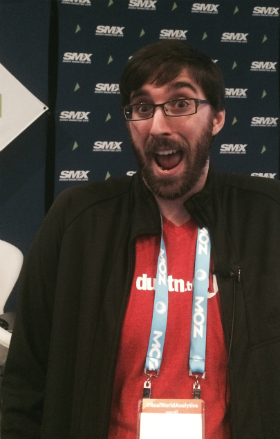 “Let’s put design talk into real world talk. This is for people who are not designers, but use visuals in their marketing,” says Stout.
“Let’s put design talk into real world talk. This is for people who are not designers, but use visuals in their marketing,” says Stout.
Fact 1: The Internet is becoming a more and more visual place.
Fact 2: Human beings have evolved to judge their environment based on visual clues.
Fact 3: The growing fragmentation of visual marketing mediums is a pain.
Create visual trust, because when something looks professional, we generally assume that it is professional.
Indicators of visual trust:
Balance
Framing
Contrast
Color
Typography
Quality
Consistency
The purpose of good visual design is to effectively communicate a message.
Balance: When the human brain looks at something visual, immediately it begins to deconstruct its structure. Balance allows us to more easily interpret what we’re seeing. Balance is the visual weight’s even distribution across a canvas. Use symmetry and asymmetry to give your image stability.
Framing: Creating even clearance around the edges of your visual piece is called framing. Pushing text all the way to the edge of an image creates tension. Use whitespace. Imagine an invisible red zone around the edge of your canvas to avoid clutter. As a general rule, keep the outer ten percent of an image clear.
Contrast: Visual distinction between text and background. What is the point of adding text if people can’t read it? Before all else, the purpose of design is to effectively communicate your message. Tip: Add a dark, semi-transparent layer to create more contrast.
Color: Using the right combinations can set an emotional and psychological tone. Speaking from an American perspective, here are some color associations:
Red: Exciting, demands attention. Studies show that the color red can actually increase your heart rate.
Orange: Fun, youthful, ambitious. Also an attention-getting color. Great for calls to action.
Yellow: Happiness, optimism. Studies show that this color causes the release of serotonin.
Green: Growth, nature. Very trendy right now. Also associated with money. Easiest color for the eye to process.
Blue: Trust, loyalty. The majority of people’s favorite color is blue. Associated with calmness and security.
Violet: Prosperity, royalty. Stimulates problem-solving. Some Silicon Valley companies paint a room Violet for problem-solving. Note: Too much violet can come off as fake.
Grey: Solid, timeless. Associated with stone or rock. Communicates sturdiness.
Brown: Earthy, organic. Associated with being natural. Can be very soothing.
White: Cleanliness, clarity and purity. Adds no extra visual weight.
Black: Elegance, power, impression of strength and authority. Often used by luxury brands.
Keep colors few and well-coordinated for maximum appeal. A few color resources:
Coolors.co
Color.adobe.com
COLOURlovers.com
Always keep your target audience in mind. What colors will speak to them? What emotion are we trying to evoke in them? Are the colors on brand?
Note: Older demographics like darker colors. Youth like brighter colors.
Typography: This is about using the right fonts. Use these tools to help you:
Fontpair.co
Typ.io
Femmebot.github.io/google-type/
Hellohappy.org/beautiful-web-type/
And remember:
Use no more than two fonts.
See how the font looks at 8px.
Don’t let style trump legibility.
Make sure you have a license or it’s free to use commercially.
Hierarchy: The most important text is the biggest. For calls to action, make sure it’s different from the rest of the page. Make the CTA highly contrasted. It should always stand out. Also, remember, the smaller the font is, the more space you need between characters.
Quality: Build an eye for detail. Pixelation is your enemy. People can tell the difference.
Consistency: Having a consistent look and feel shows intelligence and intentionality — and this creates trust.
More Design Resources on the Web
Free Photo Sites
Blogphoto.tv
Picjumbo
Mopho.to
Gratisography
Pexels
Pixabay
Death to the Stock Photo
Low-Cost, High Quality Stock Photography
iStockPhoto
PhotoDune
Lightstock
Graphic Design Applications
Photoshop
Canva
Pixelmator
Sketch
Pixlr
Gimp
Other Miscellaneous Design Tips
If you can afford it, hire a professional photographer for a day and have him take pictures all day of everything you need images of. Create your own stock photo library.
Everything for the web should be in 72 DPI — it’s the lowest common denominator.
Don’t put things on a design unless they mean things (like a line, for example).
Facebook image tip: Use an image that instantly communicates the emotion — Facebook is a very emotional platform.
The best question to ask a designer: Why did you make that choice?
The best way to tell a designer it’s not working: “It’s not achieving the result that you’re looking for.”
Bright colors and pictures of fellow millennials speak to millennials (for the latter part, remember, people look for people who look like themselves).
Pinterest tip: Taller images perform better on Pinterest (because people are looking at Pinterest on mobile devices usually). The best size? 735 by 1102 pixels.
Liveblog: How Apple’s Changing Up Search: From Siri to Safari to Spotlight #SMX
Liveblog: How Apple’s Changing Up Search: From Siri to Safari to Spotlight #SMX was originally published on BruceClay.com, home of expert search engine optimization tips.
Search engines Google, Bing and Yahoo step aside because Apple’s changing things up. This insightful SMX session discusses the many ways Apple products have impacted search and what marketers should know and do about it.
Moderator: Danny Sullivan, Founding Editor of Search Engine Land (@dannysullivan)
Speaker: Emily Grossman, Mobile Marketing Specialist, MobileMoxie (@goutaste)
Emily: Marketers Should Ride the Apple Bypass into Engagement Land
Most people at SMX will talk about Google, Bing and Yahoo. But today’s session is about Apple.
Why Apple?
Apple is growing in terms of hardware. TechCrunch reported 3000 iPhone sales a minute. The devices they sell are across the board from laptops to TV devices. In 2013, Tim Cook said Apple is not a hardware company and that there are many other things that they want to do to grow revenue.
Apple has owned these markets: App Store and Apple Music.
These markets are threatened by YouTube, Google Maps, Google Play and Google Search. Google Search gives information for free in an independent market place. In some ways search has become the ultimate threat to Apple.
Apple created three tools to address this:
Spotlight: Allows you to search content on your device, web content and other content as Apple introduces it.
Siri: Similar to Spotlight but done through voice command.
Safari: Pulling in suggested results from Apple for a while now (Apple suggested search results in Safari).
Apple wants us to think of these 3 tools collectively as Search.
Mac Users Are Growing and Loyal
The Safari browser has 53% mobile market share because iPhone users are unlikely to change their default browser.
Apple is using its three tools to cut in line, cut out Google and cut out the web.
Ride the Apple Bypass into Traffic (or Engagement) Land!
Caveat: Don’t take this as no more Google or no more Seo – we’re not in a situation where Apple is in worldwide market share for search. Don’t abandon your Google SEO.
Cutting in Line
Predictive Search – Apple does a less sophisticated version than Google Now. Apple is predicting search queries and suggesting results before the user even executes the search.
Cutting out Google
Spotlight and Siri default to Bing search over Google search for suggesting search queries.
Siri and Spotlight use Bing, and Twitter is even offered as an alternative search source before Google.
Safari still defaults to Google but provides alternative options.
Cutting out the Web
Apple is doing this by suggesting maps locations, emails, phone contacts, and especially apps.
We think of search engines as organizers of web content. Apple is trying to suggest as much info as they can outside of the web. Siri suggests contacts, apps, Apple maps first (iOS9).
Suggested specific location: rich results from Apple Maps not Google Maps. They provide directions, aggregation of data screen for a phone number and website. This is powered by Apple Maps Connect. Set up a business with Apple Maps. Choose your categories. Emily thinks the most interesting thing is that Apple publishes information on where they get their local information from.
Make your Apple Maps listings as attractive as possible.
A major way to cut the line is to get a customer to download your V Card.
Email optimization: This is happening now!
Put most important keywords in the subject line
Earlier in the subject line is better
Apple prefers recent emails to older emails
Mobile devices can only pull what is stored on the device (less than on a computer)
YouTube videos are dominating in Apple search.
YouTube Optimization Tips
Suggested iTunes content – publishers and content marketers take note! Publish content to iTunes.
Apple’s App Store commission is now at a run-rate of $9 billion! This explains why Apple is looking here. Suggested Apps (App Store Results).
Suggested Apps (Nearby Apps).
Deep App Screen Results: The newest thing in search app indexing in the new iOS 9.
Jump from a search result to a specific page in an app.
Apple is encouraging Deep App Screens in lots of places. You will see this in Apple Maps, in YouTube app, and you can get stacked results:
Apple Search App Indexing
Indexed app screens can be public or private/user specific. You could be a messaging app where all content is private and users will only see their messages.
Apple Search sources from two indexes: Device Index (private) and Cloud Index (public)
To get your website crawled by Apple you can submit your URL.
Known Ranking Factors
Engagement, installs, click-through, structured data on your website.
Apple doesn’t want interstitials in your app – they don’t rank deep app screens as high with interstitials.
The future: You may see the part of a Modern Family episode with Edward Norton.
Who’s it going to be: Apple or Google?
Closed garden or open garden.
Google is pushing HTML5 apps and it’s an experience that feels like an app. Emily feels this is the path of least resistance. The API / feed option is going to be the future (vs. apps). Apps will go up and then go down. The most popular app where you’re spending twice as much time is the browser. The browser is very powerful. She still thinks in the short-term you should have an app so you can take advantage of opportunities that are uniquely available there.
Essential Steps for Performing an Effective SEO Audit – #SMX Liveblog
Essential Steps for Performing an Effective SEO Audit – #SMX Liveblog was originally published on BruceClay.com, home of expert search engine optimization tips.
An SEO site audit lays the groundwork for everything an SEO does to ensure maximum search visibility. This SMX East session covers the most important audit tactics and best practices for making sure your SEO efforts are having the optimal impact on a site’s performance.
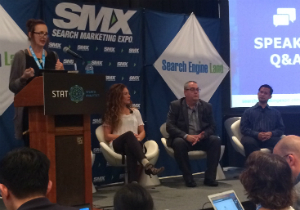 Moderator: Alex Bennert, SEO Consultant, Independent (@alexbennert)
Moderator: Alex Bennert, SEO Consultant, Independent (@alexbennert)
Speakers:
Jessie Stricchiola, Founder, Alchemist Media (@itstricchi)
Benj Arriola, Technical SEO Director, The Control Group (@benjarriola)
Bill Hartzer, Senior SEO Strategist, Globe Runner (@bhartzer)
Jessie Stricchiola: The SEO Audit
How many are here representing yourself as an individual consultant or as an agency? How many are in-house? (There’s an even split.)
Purpose: Why Audit
New to audits, sites or businesses are alike. You may be doing an audit for any of these situations and all these different audits have different requirements and purposes:
New site / startup: Doing things for SEO at the outset will save you time, money and development.
First time audit: No prior SEO.
Site redesign / CMS migration: Page templates changing, how crawlers crawl
Domain/subdomain migration: Don’t damage current exposure.
Diagnosing traffic drops/penalties: What caused this type of an audit? Often something technical on the site.
Site checkup audit: Prior SEO before and may be caused by thinking you’ve done as much SEO as you can and want to know what else to squeeze out of the fruit or other.
Discovery: Client Intake
This discovery sets the stage for the context and the narrative behind the purpose of the audit.
Why did they decide to pursue an SEO audit?
Who was the driving force behind the decision?
What are the main concerns regarding SEO?
What is the short and long-term strategy for the site?
Have the client list specific SEO questions at the outset. You’ll learn how much a team knows or doesn’t know about SEO based on the questions.
What are their specific goals and expectations?
The more inquiry you do at the outset, the more likely you are to prevent any challenges.
Discovery: Culture and SEO History
Startup or established business?
Who will be the point of contact and what is their skill level?
Development and engineering – internal, external or both?
Prior agency relationships? Why did they end?
Request historical SEO documentation.
Identify in-house SEO “owners,” as well as resources.
Discovery: Site Background
As much info as you can get will be helpful. She usually goes back about two years, about the site. Find out about:
Subdomains, mobile site, international presence
Prior SEO efforts (list and describe)
Major site changes (redesigns, HTTPS implementation, etc.)
Discovery: Page Types/Purposes
Ask the purposes for different page types/templates:
Broad topic landing pages
Subtopic focus pages
User account pages
Product pages
Pagination pages
Discovery: Performance Metrics
Understand the point of getting the content exposed. Look at:
Bounce rate
Pageviews
Tracked goals, conversions
Discovery: Topics and Audience
Prior keyword research/strategy
Paid search data (as available)
Topics supported by content
Personas and solving searcher problems
Planning: New Site Audit
Determine launch timeline.
Acquire wireframes and site architecture if available.
Determine site/product relationship.
Establish a plan for reviewing, crawling, editing staging site.
Determine owner of GSC/BWT/GA and (?).
Plan for coordinated Q/A process.
Post-launch review.
Planning: Redesigns & Migrations
Determine launch timeline.
Acquire wireframes and site architecture (if available).
Identify new CMS’s SEO needs (plugins, modules, etc.).
Planning: Traffic Drops/Penalties
Check/document historical data.
Plan to obtain crawl, backlink and related data.
Inquire about historical link-building and SEO efforts.
Inquire about historical remediation efforts.
Summary
Identify the purpose of the audit.
Interview your client or team for background information.
Investigate site history.
Plan the process specific to the audit type.
Benj Arriola: SEO Audit Breakdown

Slide 1: SEO Breakdown (click to enlarge)
In general, when you fix the foundations of SEO, you set them up and don’t need to change that again.

Slide 2 (click to enlarge)
The tools for technical SEO diagnostics: Xenu, ScreamingFrog, Deep Crawl

Slide 3: Tools for SEO diagnosis (click to enlarge)
Site architecture and SEO: The more specific you are, the longer your keywords.

Slide 4: Site architecture and keywords (click to enlarge)
Build the site architecture out for SEO.

Slide 5: Site architecture and SEO elements (click to enlarge)
Information Architecture Tools for SEO
All indexed subdomains with a site: search and also SEOQuake plugin, Scrapebox, Web CEO, SEO Powersuite
Topic hierarchy tools: DYNO Mapper and PowerMapper
Taxonomy and folksonomy tools: Google AdWords Keyword Planner and a gazillion more
Code Audit Tools
Use them and apply your own intelligence.
Page Speed
Google PageSpeed Insights
YSlow browser plugin
Readability Tools
Test to see if it’s readable by users:
Free readability scores
Clarity Grader
Mobile Phone Emulator
Is it readable by search engines?
Web Developer Toolbar
User Agent Switcher
Google Cache
Mobile sites
Tools to Check Your Content
Duplicate content: Internal is Siteliner, external is Copyscape.
Thin content: ScreamingFrog
Linkable assets: No tool checks whether you have content desirable to link to.
Panda algorithm impact: Panguin tool
Competitor content: SEMrush lets you see the keywords competitors are using that you’re not.
Backlink Analysis Tools

Slide 6: Backlink analysis tools (click to enlarge)
Quantity and Quality Tools
Backlink Factor Metrics
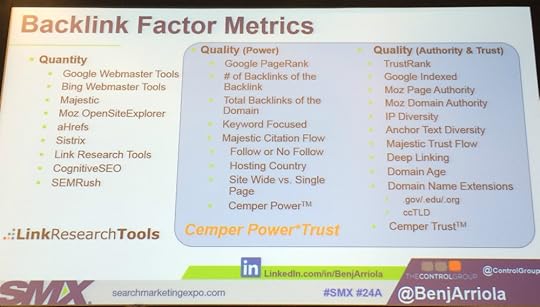
Slide 7: Backlink factor metrics to look at (click to enlarge)
Bad links
Enterprise SEO Tools
Bright Edge
Conductor
Searchmetrics
seoClarity
Note: Links to all tools are available at http://bit.ly/smx24a. You can also view Benj Arriola’s full slidedeck.
Bill Hartzer: Making the Data Usable
How will we take all the data and make it usable?
Focus on two major steps:
Analysis to make sense of data collected.
Delivering recommendations.
Step 1: Making Sense of Data Collected
Data collection is gathering copious notes.
Notepad, MS Word, Excel are all involved.
Brainstorm all potential issues.
Organize all the notes into buckets (as illustrated by kittens – left ketten is the rabbit hole kitten, center kitten is the screaming red flag kitten, and the kitten on the right represents issues you can address).
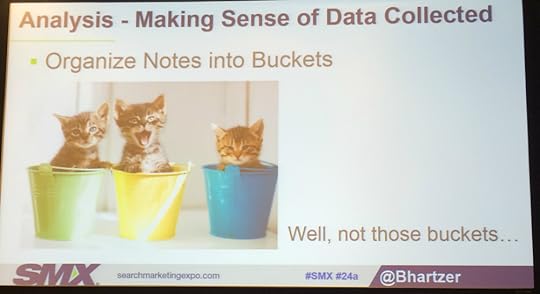
Slide 8: Kitten illustration for data organization (click to enlarge)
Some issues don’t really fall into the main topics (like schema or page speed), and may go into the miscellaneous buckets.
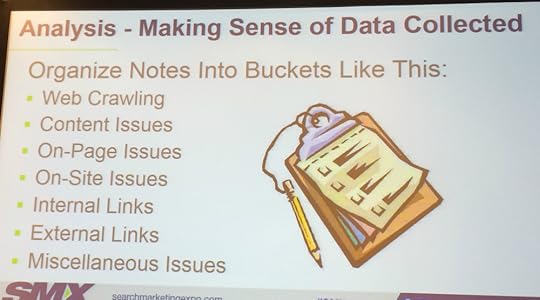
Slide 9: Buckets for organizing site audit notes (click to enlarge)
In the first few weeks, get through quick wins to make the client happy. If you do an audit, the next couple weeks are critical. Put the short-term, quick-win, biggest impact issues in a separate section of the audit.
Identify critical issues:

Slide 10: Critical issues you may find during an SEO audit (click to enlarge)
Avoid rabbit holes by putting a time limit on issues you investigate. If you go over a certain time limit, list it as an issue to check later.
Step 2: Delivering the SEO Audit
Presentation phase:
Present the data.
Show the results.
Make it look great.
Present the results:
Use internal or formal doc needed?
Who will implement? Client’s developer or outside developer?
Implement changes in-house?
MS Word doc, spreadsheets with data, PowerPoint needed for client meeting?
Formal document should include:
Cover page
Table of Contents
Overview (summary, positives, negatives)
Website crawlability
Content optimization
Linking
Overall recommendations
List of priority issues
Present action plan for implementing
Panel Q&A
How much do all these tools cost?
Bill Hartzer gives a tip: He offers to write a guest blog post about using the tool in exchange for full access to the tool.
How do you find abandoned or orphaned content?
A site command will give you a list of URLs. Scrape bots, SEO Power Suite. Bill thinks a site crawl will probably find that content somewhere, check analytics. Analyze the site’s log files and get all URLs that way. Download the Google Search Console internal link report and external link report, all pages getting search traffic, and compare them against your crawl.
Have you used open source distributed crawlers like Nutch?
Bill says that some crawlers pick up pages that some won’t, so be thorough be using multiple crawlers. Alex is a hardcore go-to fan of ScreamingFrog.
What’s the best auditing tool for local?
Moz Local and Bright Local
Given algorithm changes, how often do you redo audits for old clients?
Jessie: It gets back to what you’re tracking. There could be some things you’re tracking on a weekly basis.
Benj: All the fixes don’t get applied right away. Continue to revisit and remind them to do. It’s a constant check-in.
Do clients ever call you back to demonstrate how you helped them meet their goals?
Bill: Ideally during the audit process we try to make them understand how the changes will help. As implementing things, notate them in Google Analytics so that as you see ranking increases, you can see the change in the timeline.
Alex: It’s so important to annotate everything you do. Not just SEO things, but also algorithm updates and major changes to the site and offline things like a PR push.
Jessie: You can get a little more reliable data when you’re looking at things straight in Google Search Console.
How do you pitch value of a technical fix that might not drive monetary value but is a best practice?
Benj: Technical fixes are good for users and that can affect the bottom line. Some technical changes are proactive and protective.




